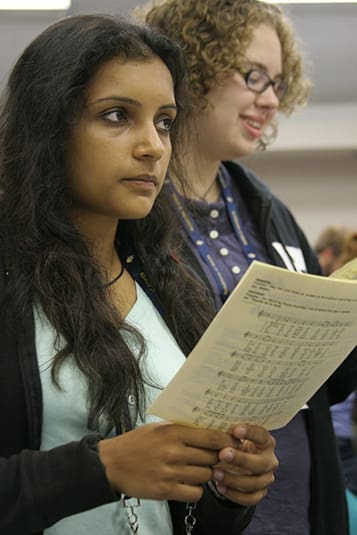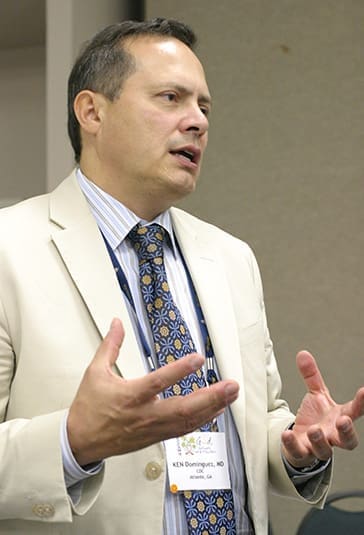 Photo By Michael Alexander
Photo By Michael AlexanderNorcross
Southeastern Catholic AIDS Ministers Convene
By ANDREW NELSON and STEPHEN O’KANE, Staff Writers | Published August 21, 2008
Connie swallows 52 medications a day to live.
Connie, who is 52, and Javier, a 30-year-old construction worker, put a face on AIDS statistics to a roomful of Catholic AIDS counselors, teachers and students.
Shedding tears, each told a story of exclusion from community and church. They used only first names.
Javier said he told an Atlanta priest ordained in May about his illness and suddenly the priest stopped visiting. This was after he was told to stop attending his men’s prayer group.
“Even now, nobody comes to visit me at my house because I have HIV,” he said, speaking in Spanish through a translator. “My church has isolated me and left me by myself,” he said.
Connie has lived with the disease for more than 20 years. She said her pastor back in the 1980s encouraged her to sit in the rear of her parish church in rural Minnesota and not to receive Communion from the cup.
Connie was encouraged to quit her job as an office manager in a travel agency. She and her husband rely on government assistance and his salary as a grounds- keeper to pay for the drugs. Her medicine costs about $60,000 a year.
Over the years, she said her pastor did not advocate on her behalf to the church community. She recently found a new Catholic parish but remains cautious.
“It felt alive, and the people seemed so friendly,” she said. “There are a few people who know, but I haven’t shared with anybody because I am afraid.”

Niky Chokshi, foreground, a marketing and international business major at Villanova University, Villanova, Pa., and Sarah Krosse, an English major and peace and justice minor at Ohio Dominican University, Columbus, Ohio, participate in the morning prayer service during the Southeastern Conference Of Catholic AIDS Ministers (SECCAM08). The young women are two of the 25 male and female members of Catholic Relief Service’s HIV Action Team who attended the conference. Photo By Michael Alexander
The two spoke Aug. 13 before nearly 150 people gathered for the first Southeastern Conference of Catholic AIDS Ministers. Held at the Simpsonwood complex, it brought together Catholic ethicists, medical professionals, clergy and students for a weeklong study of the disease.
Irene Miranda, the director of the Atlanta Archdiocese HIV/AIDS ministry office, said the South now represents the largest population of new HIV infections in the United States.
“We cannot ignore” how HIV and AIDS have affected entire communities, she said.
The numbers are sobering. In 2007, some 33 million people around the world live with HIV/AIDS and in the United States, more than 1 million have the disease.
And in Georgia, the number of people living with HIV/AIDS is nearly 33,000, an increase of almost 27 percent between 2004 and 2007, according to recent reports.
“The HIV pandemic remains the most serious of infectious disease challenges to public health,” said Msgr. Robert Vitillo, the head of Caritas Internationalis, the Geneva-based umbrella organization for national Catholic charities around the world.
Even though more people have access to HIV/AIDS treatments, the future remains grim, he said.
“More challenges were identified … than progress made,” he said about a recent analysis of the global situation.
During the opening Mass Aug. 12, Archbishop Wilton D. Gregory likened the workers to the Gospel story of the shepherd seeking the one lost sheep.
“We struggle to pursue a similar sheep,” he said about those living with HIV/AIDS. “We must approach them gently, tenderly.”
People in this ministry already know that caring for the people who are stigmatized will not be easy, he said.
“As you meet here in the Archdiocese of Atlanta … you have to realize that if you are going to pursue the sheep that is lost, it is going to cost you,” he said.
In The South
In Atlanta’s backyard, a new face of HIV/AIDS is forcing activists to rethink prevention and education strategies as the disease moves into the black and Latino community and rural areas.
Findings from the 2008 Southern AIDS Coalition show:
- The South has the highest number of adults and young people living with AIDS in the country.
- Of the 20 states with the highest rates of persons living with HIV (not AIDS) in 2006, 11 are in the South.
- Of the 15 states with the highest rates of new HIV diagnoses, nine are in the South.
- A challenge for the region is the high prevalence of HIV-infected individuals in rural areas. Southern states comprise 65 percent of all AIDS cases among rural populations.
Miranda said it’s a myth that the disease is under control.

Charles Greene of Wilmington, N.C., listens to one of the speakers during the SECCAM08. Greene attended the conference with Gaye Hieb, program director for Wilmington’s Coastal AIDS Resource Effort (C.A.R. E.). Photo By Michael Alexander
“There are big gaps. There are large numbers of people who fall into those gaps,” she said. Existing programs need to be reconsidered to ensure the efforts reach the new groups of people exposed to the disease, she said.
Blacks and Latinos are communities grappling with the disease in large numbers, she said. And increasingly there is a “feminization” of HIV, which is an issue since women are usually the caregivers, she said.
“As the demographics change, the needs change,” said Miranda.
Church Strengths And Challenges
The church has long served people with the disease. At the same time, the church also faces challenges as the epidemic approaches the 30-year anniversary since it was first diagnosed.
In an interview, Msgr. Vitillo said the church has an unmatched global reach. Groups fighting AIDS often appear when money is available for them to reach new communities, he said.
“The church was there long before HIV came on the scene, and some day hopefully we’ll have a solution and the church will be there long after, probably responding to lots of other emergencies as well,” he said.
There isn’t a “magic solution” to the disease, he said, so the church talks about behavior change that will cut down on the transmission of the disease.
“(The church) has lasting values. It is based on lasting values and it communicates those values. It must remind (people) of their responsibilities for themselves and to others,” he said.
Asked the strengths and challenges of the church in dealing with HIV/AIDS, Jesuit Father Ken Overberg, an ethics professor at Xavier University, Cincinnati, said the church relies on experts to understand the disease and then adds to it with a faith perspective. He spoke at the conference on AIDS and the consistent ethic of life.

Kenneth Dominguez, MD, of the Centers for Disease Control, Atlanta, provided an AIDS medical update during his August 13 presentation. Photo By Michael Alexander
Since the diagnosis of the disease, the U.S. bishops have twice issued pastoral letters, urging Catholics to show compassion for people living with HIV/AIDS, he said. And yet the mandates to care for victims “haven’t yet touched the hearts and minds and actions of the people of God,” he said.
He said another challenge facing Catholics is reconciling the church’s teaching against condom use in the context of HIV/AIDS.
While health organizations and governments have emphasized condom use to prevent the spread of HIV, Catholic church leaders have argued against this and supported abstinence outside of marriage and fidelity in marriage as the way to prevent the spread of the disease.
“We need to do the hard homework of forming our conscience,” he said. Catholics should study “Humanae Vitae,” the 1968 encyclical on married love and procreation, and understand it. And then consider it in the current context of HIV/AIDS, he said.
Key Vatican congregations have been studying the medical, moral and theological dimensions of the question of condom use in HIV prevention.
“Some people will say we are not talking about life preventing, we are talking about life preserving,” Father Overberg said. “Is this a different kind of reality? Ought we be thinking in new ways? I think that remains a challenge, especially for the official church.”
On the strengths of the church, he said the Catholic faith has a “profound strength of a holistic approach to life and therefore to HIV and AIDS.” And Catholic social teaching challenges structures or government policies that exacerbate the spread of the disease, such the oppression of women or an economy that makes the poor poorer so they cannot afford medical treatment.
“Ultimately we’re in God’s hands, and this doesn’t diminish our responsibility,” he said.